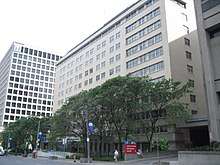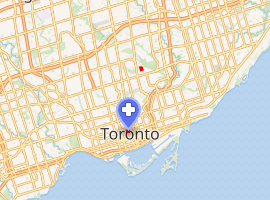Toronto Rehabilitation Institute
Toronto Rehabilitation Institute, simply known as Toronto Rehab, is the largest rehabilitation hospital in Canada. Owned and operated by the University Health Network, Toronto Rehab provides patients with rehabilitation care, helping people rebuild their lives and achieve individualized goals. It is composed of five sites across Downtown Toronto, which are: Bickle Centre (130 Dunn Avenue), Lakeside Centre (150 Dunn Avenue), Lyndhurst Centre (520 Sutherland Drive), Rumsey Centre (345 and 347 Rumsey Road), and University Centre (550 University Avenue).
| Toronto Rehabilitation Institute | |
|---|---|
| University Health Network | |
 Entrance to the University Centre site of the Toronto Rehabilitation Institute | |

| |
| Geography | |
| Location | Toronto, Ontario, Canada |
| Organization | |
| Care system | Medicare |
| Type | Specialist |
| Affiliated university | University of Toronto |
| Services | |
| Emergency department | No |
| Speciality | Rehabilitation |
| History | |
| Opened | November 2, 1998 |
| Links | |
| Website | UHN.ca/TorontoReHab |
History
In 2011, Toronto Rehab opened The iDAPT Centre Rehabilitation Research, where technologies and treatments to enhance the lives of people who are aging, ill or injured are tested in simulated environments.
On July 1, 2011, the Toronto Rehabilitation Institute became a part of the University Health Network.[1]
By a Special Act of Legislation, on November 2, 1998, the Toronto Rehabilitation Institute was created with the amalgamation of three hospitals. These were:
- Rehabilitation Institute of Toronto
- Lyndhurst Spinal Cord Centre
- Toronto Rehabilitation Centre
Lyndhurst Spinal Cord Centre was established in 1945 as Lyndhurst Lodge to deal with returning Canadian veterans with spinal injuries from World War II.[2] The institution was named after the street of first site on Lyndhurst Avenue in Toronto and led by Albin T. Jousse. In 1950 it was acquired by the Canadian Paraplegic Association and by 1974 it moved to the current and larger location, the former site of Mount Sinai Hospital when Mount Sinai moved to a new facility next door. In 1998 it merged with several other rehabilitation institutions to form TRI.
Rehabilitation Institute of Toronto was formed in 1997 with the merger of two other hospitals, Queen Elizabeth and Hillcrest Hospitals. Queen Elizabeth Hospital was established in 1874 as a chronic care and long term health care facility. In the 1930s services added included physiotherapy and occupational therapy. By the 1970s it became a dedicated rehabilitation institution. Hillcrest Hospital opened in 1886 as long-term care and evolved into a rehab institution the 1970s. It specializes in care for stroke, cardiac and amputees patients needing rehabilitation needs.[2]
Toronto Rehabilitation Centre was created in 1922 to deal with long term health care needs of Canadian veterans of World War I.[2]
Programs
Programs currently offered at Toronto Rehabilitation Institute include:
- Spinal cord rehabilitation
- Stroke rehabilitation
- Acquired Brain Injury rehabilitation
- Geriatric psychiatry rehabilitation
- Cardiovascular prevention and rehabilitation
- Complex continuing care
- Geriatric medicine rehabilitation
- Musculoskeletal and oncological rehabilitation
- Chronic pain rehabilitation services
- Long term care
References
- "UHN History". UHN. University Health Network. 3 May 2012. Retrieved 3 December 2019.
- "Toronto Rehab History". UHN. University Health Network. 22 December 2008. Retrieved 3 December 2019.